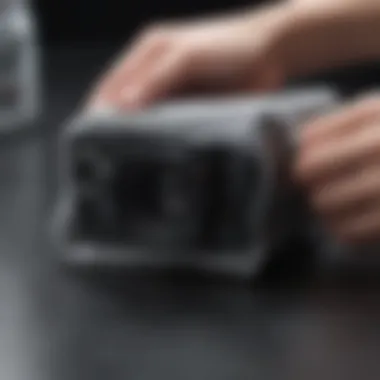Best Cleaner for LCD TV Screens: Ultimate Guide


Intro
This article serves as a thorough guide to finding the suitable cleaning solutions and methods tailored specifically for LCD TV screens. It will cover different types of cleaners, suitable cloths, and techniques that help avoid common pitfalls that damage screens. By providing clear, actionable steps, readers will be better equipped to extend the lifespan of their devices while ensuring optimal viewing performance.
Understanding how to clean these screens safely will enhance your viewing experience. A clean television screen can make all the difference, eliminating distractions caused by dust, fingerprints, and smudges. This maintenance not only improves picture clarity but also contributes to the overall aesthetic of a living space.
In the following sections, we will delve deeper into the available cleaning options, recommended tools, and preventative measures that will protect your investment. Furthermore, it is crucial to highlight the significance of selecting the right materials and methods for effectively maintaining your LCD TV screen. Let’s explore the path to crystal-clear screens without compromising their integrity.
Understanding Screens
Understanding LCD screens is critical to maintaining their performance and lifespan. With the increasing reliance on LCD technology in both personal and professional environments, it is essential to grasp how these screens function and the specifics that make them unique. This knowledge not only informs how we clean and care for these devices, but it also enhances our viewing experience by protecting the quality of the display.
Definition and Functionality
Liquid Crystal Display (LCD) screens operate by using liquid crystals between layers of glass or plastic. These liquid crystals do not emit light by themselves. Instead, they manipulate light that is passed through them. This process creates the imagery we see on our screens. When a signal reaches the LCD, it causes the crystals to align in certain ways, controlling the light passage and color combinations to generate the desired image. In effect, they can display a wide range of colors and contrasts which makes them popular in televisions and computer monitors.
Advantages of Technology
LCD technology presents multiple advantages. Key benefits include:
- Energy Efficiency: LCD screens consume less power compared to traditional cathode-ray tube displays (CRT), making them both environmentally friendly and cost-effective.
- Slim Profile: Their design allows for thin, lightweight screens that are easy to mount or position in various settings.
- High Resolution: LCD displays often provide better resolution, supporting clearer images with fine detail. This quality is crucial for activities like gaming and watching films.
- Reduced Eye Strain: Many users find LCD screens less tiring for the eyes compared to older technologies, thanks to better brightness control and flicker rates.
Given these advantages, recognizing the operational mechanics of LCD screens becomes foundational not just for usage but also for ensuring their upkeep. The more informed one is about the technology, the better the maintenance practices will translate to enhanced display longevity.
The Importance of Proper Cleaning
Cleaning an LCD TV screen correctly is essential. Many people underestimate the significance of proper cleaning, thinking that any cleaning solution will do. However, cleaning an LCD screen involves careful consideration. Using the right technique and product prevents damage while ensuring a clear display. The use of improper methods can lead to various issues that affect the quality of the screen, making this topic vital for any LCD TV owner.
Impact on Display Quality
Quality of display directly relates to how clean the screen is. Dust, fingerprints, and smudges can interfere with the clarity and overall enjoyment of visual content. When the screen is dirty, colors may appear distorted, and contrast can diminish. This can disrupt viewing experiences during films, videos, or games. Moreover, excessive residue can create a haze over the screen, further impairing the functionality.
Using a proper cleaning approach restores and enhances display quality. Glass cleaners, ammonia-based products, or general household cleaners can often be too harsh. Chemical ingredients might cause cloudiness or discoloration on the screen’s surface. Instead, opting for specialized LCD screen cleaners can maintain the integrity of displays. Microfiber cloths should be used instead of paper towels, as they leave fewer particles and scratches.
Preservation of Screen Longevity
The longevity of an LCD screen is directly affected by how often and effectively it is cleaned. Regular, careful cleaning helps extend the life of the television. Methodical maintenance ensures that the delicate surface layer remains intact. If screens are cleaned improperly, it may lead to irreversible damage. For example, strong chemicals can strip off the protective coatings that manufacturers place on screens. This type of damage can degrade the performance of the television over time.
In addition to better quality, proper cleaning can save money in the long run. With a better-maintained screen, the need for repairs or even replacement can be minimized. Investing time in understanding how to properly clean an LCD TV can yield significant benefits. It is well worth taking the time to learn the best practices.
Common Cleaning Solutions
Understanding the various cleaning solutions available is crucial for maintaining the clarity and performance of LCD TV screens. With the right products, one can preserve the integrity of the screen while ensuring optimal viewing experiences. This section explores different cleaning solutions, specifically focusing on commercial cleaners, homemade alternatives, and the use of plain water. Each subsection will detail the advantages, potential concerns, and effectiveness of these methods.
Commercial Cleaners
Commercial cleaners designed for LCD screens are widely available in the market and are specifically formulated to deal with the unique properties of these displays. These products often feature a combination of gentle surfactants and solvents that effectively dissolve fingerprints, dust, and smudges without scratching or damaging the screen surface.
One significant benefit of using a commercial cleaner is its convenience. Most come in easy-to-use spray bottles, allowing for quick application. Moreover, these cleaners typically include information about safe usage and ingredients, helping users make informed choices.
However, it is important to check that the cleaner is labeled safe for LCD screens. Some general-purpose cleaners may contain alcohol, ammonia, or other harsh chemicals that could strip away protective coatings, potentially causing long-term damage. Consider looking for well-reviewed options such as iKlear and Screen Mom. These brands have established a reputation for safety and effectiveness.
Homemade Solutions
For those inclined towards DIY, homemade cleaning solutions can also be effective for maintaining LCD screens. These mixtures often include common household items that provide a gentle cleaning action without harmful chemicals. A prevalent recipe includes combining distilled water with a small amount of white vinegar in a spray bottle. This solution can effectively cut through grime without risking screen damage.


Using homemade cleaners is generally cost-effective. Furthermore, it allows users to control the ingredients, reducing exposure to potentially irritating chemicals. Nevertheless, care should be taken with the concentrations used. Too much vinegar can be harsh, and incorrect mixtures might leave residue. Testing a small area of the screen before applying extensively is wise.
Water as a Cleaning Agent
Plain water is often an underrated cleaning agent that can handle light cleaning tasks for LCD screens. Using a microfiber cloth lightly dampened with distilled water can successfully remove dust and light smudging. Water is non-toxic and poses minimal risk of chemical damage, making it a safe choice for frequent cleaning.
While water alone may not be sufficient for tougher stains or grease marks, it serves as a gentle first step in the cleaning process. For dirtier screens, follow water usage with a more specialized cleaner or one of the suggested homemade solutions.
"Always refer to the manufacturer's guidelines regarding screen cleaning to avoid any unintended damage."
In summary, each type of cleaning solution presents its own merits and considerations. Commercial cleaners offer convenience and effectiveness, while homemade solutions provide control over composition. Using water remains a practical and safer alternative for light cleaning tasks.
Evaluating Cleaner Effectiveness
When discussing how to maintain LCD screens, evaluating cleaner effectiveness is pivotal. The right cleaning solution can vastly improve viewing quality and preserve the longevity of the device. Each cleaner may boast different features. Therefore, understanding their composition, user feedback, and visual outcomes can inform better purchasing decisions. This understanding also reduces the risk of causing unintended damage to the screen.
Composition Analysis
The composition of a cleaner greatly influences its effectiveness. Most commercial LCD cleaners contain specific surfactants and solvents designed to break down oils and dust without harming the screen's surface. On the other hand, some homemade solutions may use common household ingredients like vinegar or alcohol. While these may seem effective, the concentration matters. High concentrations can strip protective coatings on screens, leading to increased glare and reduced image quality.
Consider checking the ingredient list before using any product:
- Surfactants help eliminate grime.
- Solvents dissolve oily residues.
- pH balanced solutions prevent corrosion.
It's essential to choose a cleaner specifically formulated for LCD screens to avoid any potential screen defects or reduces in clarity over time.
User Reviews and Experiences
Examining user testimonials offers practical insights into a cleaner's effectiveness. Many individuals share their experiences in forums or review sections of e-commerce sites. Positive feedback often highlights how effective the product was in removing smudges and fingerprints without leaving streaks.
Some common subjects found in reviews include:
- Ease of use: Products that come with a spray bottle often receive better reviews due to convenience.
- Streak-free results: Users appreciate solutions that clean without leaving residues.
- Safety considerations: Many prefer green or eco-friendly options, especially if children or pets are around.
Negative reviews can serve as warnings about products that may cause screen damage or fail to clean effectively. Learning from these shared experiences will guide users towards more effective solutions, supporting informed decisions for maintaining their LCD screens properly.
Visual Results Post-Cleaning
The ultimate test of a cleaner's effectiveness is in the visual results it delivers. After cleaning, a screen should exhibit clarity, vibrant colors, and minimal glare. For those serious about their viewing experience, it may be helpful to run a comparative test by cleaning a small section first. Observe how the cleaned area looks compared to the uncleaned section. Signs of effective cleaning include:
- Improved brightness: Colors should appear more vivid.
- Reduced reflections: Less glare enhances viewing experience.
- Sharp details: Text and images will have better definition.
Always pat dry with a soft cloth after applying any cleaner. This will prevent streaks left from moisture evaporation, ensuring the best visual results.
“A clean screen not only improves viewing quality but also elongates the life of your LCD.”
Cleaning Techniques
Cleaning techniques are essential for maintaining the quality and longevity of an LCD TV screen. It's not just about removing dust or fingerprints; incorrect methods can lead to lasting damage. Proper cleaning techniques ensure that screens stay clear and free from streaks, preserving their visual clarity and function.
When considering cleaning methods, it's crucial to use the right tools and materials. Using the wrong equipment or cleaners can result in scratches, chemical damage, or even the removal of protective coatings on the screen. Therefore, understanding proper techniques and tools is vital in effectively maintaining the intricate technology of an LCD screen.
Necessary Cleaning Tools
Cleaning tools play an integral part in ensuring a successful screen cleaning process. Below are keys tools that should be part of your cleaning kit.
Microfiber Cloths


Microfiber cloths are renowned for their ability to trap dirt and dust without causing scratches. These cloths are soft and non-abrasive, making them an ideal choice for delicate surfaces like LCD screens. A key characteristic of microfiber is its fine fibers, which increase the surface area and enhance cleaning efficiency.
Their unique construction allows them to lift and hold onto particles, effectively preventing them from being smeared across the screen. One of the advantages is that they are reusable, which is environmentally friendly. However, care should be taken to wash them without fabric softeners, as this can reduce their effectiveness.
Spray Bottles
Spray bottles are essential for applying cleaning solutions evenly across the screen. The ability to control the amount of cleaner used is a beneficial aspect of spray bottles. A key characteristic is their versatility; they can be used for various cleaning agents, from commercial cleaners to homemade solutions.
Their design allows for an even misting, which helps prevent excessive liquid accumulation, reducing the risk of damage to internal components of the TV. However, users must ensure that they do not spray directly onto the screen. Instead, it is best practice to spray the cloth before applying it to the screen.
Soft Brushes
Soft brushes are effective for removing stubborn dust and debris without scratching the screen. Their gentle bristles can reach into crevices and corners, ensuring a thorough clean. A noteworthy feature is their ergonomic design, which allows for comfortable handling during cleaning processes.
Using soft brushes can help in maintaining a dust-free environment, especially in households where dust accumulates quickly. However, it's crucial to choose brushes that are designed specifically for electronics to avoid using stiff bristles that might scratch the screen.
Step-by-Step Cleaning Process
Cleaning an LCD TV screen should be systematic to ensure efficacy and prevent damage. Here is a simple guide for a safe cleaning process:
- Power off the TV: Always start with the TV turned off to avoid any electrical issues and to see dust and smudges clearly.
- Use a microfiber cloth: Begin by gently wiping the screen with a dry microfiber cloth to remove loose dust.
- Prepare cleaning solution: If there are stubborn stains, use a cleaning solution suitable for LCD screens, preferably diluted in water or a store-bought cleaner. Avoid ammonia-based cleaners.
- Lightly spray the cloth: Mist the microfiber cloth with the cleaning solution to avoid excessive liquid. Do not spray the screen directly.
- Wipe gently: Use smooth, circular motions to clean the screen, avoiding excessive pressure. It is best to start from the top and move downward to prevent streaking.
- Final touch: Check for any remaining streaks or spots. If there are, repeat the process if necessary.
Following these steps ensures a cleaner screen and better viewing experience, contributing towards enhanced longevity.
Potential Damage from Incorrect Cleaning
Proper cleaning of LCD TV screens is not just about aesthetics; it directly impacts both functionality and longevity. Incorrect cleaning methods or materials can lead to significant damage. Such damage may manifest in ways that are not only visually unappealing but can also degrade the performance of the screen. Understanding these potential damages is vital for anyone looking to maintain their LCD devices effectively.
Screen Scratches
Scratches on the screen can occur easily if abrasive materials are used during the cleaning process. Simple actions, such as using a rough cloth or scrubbing too hard, can create deep marks that affect display quality. These imperfections not only look unsightly but can also lead to further issues by creating spots prone to dirt and grime accumulation.
To avoid such frustrations:
- Always opt for microfiber cloths, which are gentle yet effective.
- Employ a light touch when cleaning the screen.
Chemical Damage
Some commercial cleaners contain harsh chemicals that, while effective on other surfaces, are not suitable for LCD screens. Ingredients such as ammonia and alcohol can strip away essential coatings, which are designed to protect the screen and enhance its picture quality. Utilizing these chemicals may result in discoloration or cloudiness.
When choosing a cleaner, verify the label thoroughly. Many reputable brands will indicate that their products are safe for LCD screens.
Screen Coating Removal
LCD screens often come with protective coatings that help reduce glare and improve clarity. These coatings can be damaged or removed with the wrong cleaning products. Many users are unaware that the solution they are using might be degrading these coatings over time.
To prevent this, it's advisable to:
- Seek cleaners specifically designed for LCD screens.
- Avoid using paper towels or other materials that could strip the screen coating during the cleaning process.
Remember, taking proactive steps to choose the right cleaning materials and methods will protect your investment and enhance your viewing experience.
In summary, the potential damage from incorrect cleaning methods encompasses a range of issues from scratches to chemical damage and removal of protective coatings. Each of these risks reinforces the importance of informed cleaning practices.
Recommended Products


Selecting the right products for cleaning LCD TV screens is crucial for maintaining their clarity and longevity. This section will delve into several recommended products, both commercial and homemade, that have proven effective. Understanding these options helps ensure the continued functionality and aesthetic appeal of a highly utilized device.
Top Commercial Cleaners Reviewed
When it comes to commercial cleaners, the market offers a wide variety of options designed specifically for LCD screens. These products typically include ingredients that are safe for delicate surfaces while providing effective cleaning capabilities. Here are some notable examples:
- Whoosh! Screen Cleaner: This cleaner is ammonia-free and effectively removes fingerprints and smudges. User feedback often highlights its efficacy in restoring clarity without leaving streaks.
- Endust: This product comes in an easy-to-use spray format. It not only cleans but also dusts screens, making it a dual-purpose solution.
- Screen Mom: Known for its biodegradable formula, Screen Mom provides a safe cleaning experience. Buyers praise its non-toxic ingredients, making it suitable for households with children.
For optimal results, it is advisable to follow the instructions provided by the manufacturer. This ensures that the cleaner interacts appropriately with the screen surface.
Effective Homemade Recipes
Homemade cleaners offer an alternative for those who prefer a more natural approach. These recipes can be equally effective and economical. Here are a few that have garnered positive feedback:
- Vinegar and Water Solution: Mixing equal parts of distilled white vinegar and water creates a gentle solution. This can effectively cut through grime without causing damage.
- Isopropyl Alcohol Mix: A solution using 70% isopropyl alcohol diluted with water in a ratio of 1:1 is effective for removing dirt and oils. However, it’s critical to ensure this mixture is applied using a soft cloth, avoiding excessive saturation.
- Cornstarch Cleaner: Combine cornstarch with water to form a paste. This mixture helps eliminate stubborn spots and can provide a polishing effect.
Note: While homemade solutions can be effective, it is essential to ensure no harsh chemicals are included. Testing the cleaner on a small, inconspicuous area can help determine compatibility.
Using the right cleaning products is vital to preserving the functional and aesthetic qualities of your LCD TV screen. Whether opting for a commercial cleaner or a homemade recipe, the understanding of their effectiveness can greatly enhance your cleaning routine.
Expert Tips for Maintenance
Maintaining the quality and longevity of your LCD TV screen hinges on understanding effective cleaning practices and usage habits. This section provides critical insights that can safeguard your device while ensuring a pristine display experience. With the right approach, you can minimize the accumulation of dust and fingerprints, which ultimately enhances your viewing pleasure.
Frequency of Cleaning
The frequency of cleaning your LCD TV screen directly relates to your environment and usage patterns. Generally, it is advisable to clean the screen at least once every few weeks. However, if your TV is located in a high-traffic area or is often exposed to pet hair or cooking fumes, more frequent cleaning may be necessary.
- For households with children or pets, consider cleaning the screen weekly.
- If the TV is part of a home theater system that is used frequently, a bi-weekly cleaning routine could be beneficial.
- In contrast, if the TV is in a less utilized space, monthly cleaning might suffice.
Regardless of how often you clean, always pay attention to the clarity of the display. If you notice a decline in picture quality due to smudges or dust buildup, it is time to clean.
Best Practices for Usage
How you use your LCD TV can significantly affect its cleanliness and functionality. Simple daily habits can help reduce the need for frequent cleaning and maintain optimal screen quality.
- Avoid Touching the Screen: Frequent touching can lead to fingerprints and smudges. Educate others in your household to avoid touching the screen directly.
- Use Equipment Wisely: Consider using a remote control rather than buttons on the TV. This limits contact with the screen.
- Proper Placement: Position the TV away from direct sunlight, as excessive brightness can cause glare and encourage dust to settle more quickly. Instead, opt for controlled lighting in the room.
- Regular Dusting: Use a soft microfiber cloth to dust the screen regularly without touching it. This habit helps remove dust before it accumulates.
- Control Environmental Factors: Maintain a clean surrounding space. Regularly vacuum and dust the area around the TV to minimize dust migration onto the screen.
Remember, a good maintenance routine leads to a longer lifespan for your LCD screen.
By applying these expert tips, you not only enhance your viewing experience but also protect your investment from damage and deterioration over time.
Ending
Proper cleaning is not just about aesthetics; it is fundamental for device performance and durability.
Furthermore, as technology advances, we must be aware of the evolving landscape of cleaning products. New formulas can emerge, promising better results and less risk of damage. Therefore, continuing to educate oneself on these developments is crucial in making informed decisions for care and maintenance.
Recap of Key Points
To summarize the main discussions in this article:
- Understanding LCD Screens: The nature and functionality of LCD technology.
- Importance of Proper Cleaning: How it affects display quality and screen longevity.
- Common Cleaning Solutions: Distinction between commercial cleaners, homemade recipes, and the use of water.
- Evaluating Cleaner Effectiveness: Analysis of ingredients, user reviews, and visual outcomes.
- Cleaning Techniques: Identifying necessary tools and following a step-by-step cleaning guide.
- Potential Damage from Incorrect Cleaning: Risks like scratches, chemical damage, and removal of screen coatings.
- Recommended Products: Reviews of conducting commercial and homemade solutions.
- Expert Tips for Maintenance: Ideal cleaning frequency and best practices.
These points reinforce the critical need for careful selection and application of cleaning materials specific to LCD screens.
Future Considerations
Looking ahead, there are several aspects to consider:
- Innovations in Cleaners: As manufacturers develop new products, it is worthwhile to explore these advancements. Future cleaners may provide better protection and enhance cleaning efficiency with less environmental impact.
- Environmental Impact: Consider eco-friendly products that do not harm the planet while effectively cleaning screens.
- Changes in Technology: As TV technology evolves, there may be new considerations for cleaning that differ from traditional methods. Being aware of your specific screen type is essential for choosing the right cleaning approach.
- User Education: Continuing to share knowledge about proper care can significantly lessen the chances of damage caused by misinformation.
In essence, a continued commitment to understanding and applying the best practices for LCD TV cleaning will enhance the experience for users, ensuring their devices remain in prime condition.







